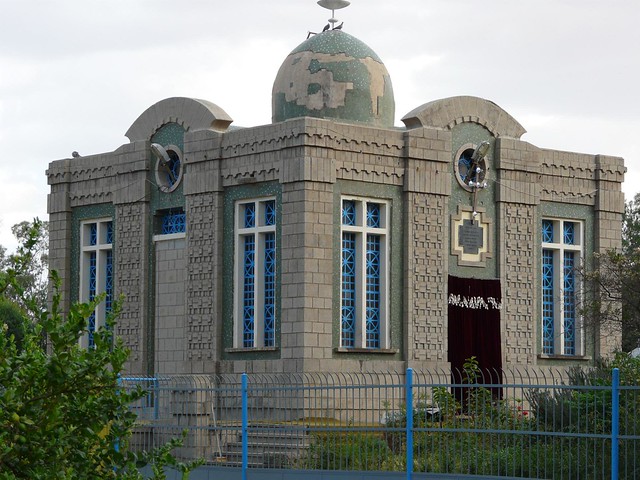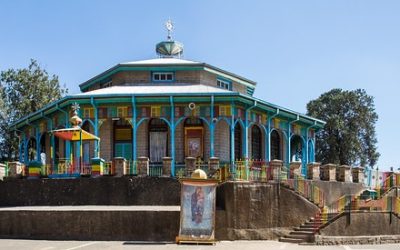Historical Significance of the Ark of the Covenant in Ethiopia
The Ark of the Covenant holds a profound historical and religious significance in Ethiopia, believed to be the sacred chest that contains the original Tablets of Stone inscribed with the Ten Commandments. According to Ethiopian tradition, the Ark was brought to Ethiopia by Menelik I, the son of King Solomon and the Queen of Sheba, making it a central symbol of Ethiopian Christianity and identity. Its reputed presence in the Church of Our Lady Mary of Zion in Axum has attracted pilgrims and historians alike, underscoring Ethiopia’s unique spiritual heritage and its longstanding claim as the rightful custodian of this ancient relic.
Origins and Biblical Background
The Ark of the Covenant holds profound historical and spiritual significance in Ethiopia, where it is believed to be housed within the Church of Our Lady Mary of Zion in Axum. According to Ethiopian tradition, the Ark was brought to Ethiopia by Menelik I, the son of King Solomon and the Queen of Sheba, making it a central symbol of Ethiopian identity and sovereignty. This ancient relic is revered as a divine connection between God and the Ethiopian people, representing both religious faith and national heritage.
- Origins: Traditionally, the Ark is believed to have been constructed during the time of Moses, following detailed instructions received from God on Mount Sinai. Its presence in Ethiopia is thought to date back over a thousand years, making it one of the oldest surviving religious artifacts.
- Biblical Background: The Ark of the Covenant is described in the Old Testament as a sacred chest containing the stone tablets of the Ten Commandments, crafted by the Israelites to serve as a divine symbol of God’s covenant with His people. It played a pivotal role during the Israelites’ wanderings in the desert and their conquest of Canaan.
- Historical Significance in Ethiopia: Ethiopian tradition attributes the Ark’s arrival to the Queen of Sheba’s visit to King Solomon, with subsequent migration of the relic to Africa. It symbolizes divine protection and legitimacy for Ethiopian rulers and is a key element of the Ethiopian Orthodox Church’s religious practices.
- Iconography and Cultural Impact: The Ark’s reputed location in Axum has made it a focal point for pilgrims and believers, fostering a deep cultural and spiritual connection. Its presence continues to influence Ethiopian art, architecture, and religious observances.
Integration into Ethiopian Religious Tradition
The Ark of the Covenant holds a profound historical and spiritual significance in Ethiopia, serving as a central symbol of faith and national identity. According to tradition, the Ark was brought to Ethiopia by Menelik I, son of King Solomon and the Queen of Sheba, making it a divine heritage linked to biblical origins. This belief has fostered a deep religious reverence among Ethiopians, positioning the Ark as a sacred relic that embodies divine presence and authority. The Ethiopian Orthodox Tewahedo Church integrates the Ark into its religious practices and rituals, viewing it as a divine gift that connects the congregation to God’s eternal covenant. Its protective and miraculous reputation reinforces its role within Ethiopian spiritual life, making it a unifying symbol across generations. Over centuries, the Ark has been woven into the national consciousness, influencing religious ceremonies, art, and cultural identity, thus cementing its place as a cornerstone of Ethiopia’s Christian heritage and historical legacy.
Role in Ethiopian Identity and Culture
The Ark of the Covenant holds profound historical significance in Ethiopia, serving as a symbol of national identity and spiritual heritage. According to Ethiopian tradition, the Ark was brought to Ethiopia by Menelik I, the son of King Solomon and the Queen of Sheba, making it a central element of Ethiopian Christian heritage. Its legendary residence in the Church of Our Lady Mary of Zion in Axum has reinforced its mystique and cultural importance over centuries. The Ark is viewed not only as a sacred religious artifact but also as a divine symbol that links Ethiopia directly to biblical history, fostering a sense of unique national pride and religious devotion. It plays a vital role in Ethiopian culture, inspiring religious ceremonies, national identity, and cultural continuity that unites the Ethiopian people across generations.
Location and Custodianship
The concept of location and custodianship plays a crucial role in the history and significance of the Ark of the Covenant in Ethiopia. This sacred artifact is believed to be housed in unique sites that are meticulously protected and revered, reflecting the deep spiritual and cultural heritage of the Ethiopian tradition. Understanding the significance of its location and the custodians responsible for its safekeeping offers insight into its enduring mystery and reverence among believers and historians alike.
St. Mary of Zion Church in Axum
The St. Mary of Zion Church in Axum holds a significant place in Ethiopian religious history as one of the most revered sites related to the Ark of the Covenant. Located in the ancient city of Axum, the church is believed to be the rightful custodianship of the sacred Ark, which is said to reside within its sacred confines.
According to Ethiopian tradition, the Ark of the Covenant has been kept in the Church of St. Mary of Zion for centuries, with custodianship traditionally held by a chosen guardian known as the “Guardian of the Ark.” This role is passed down through generations, and the guardian is responsible for safeguarding the Ark from exposure and ensuring its sanctity.
The church itself is located in the heart of Axum, a city that was once the capital of the ancient Aksumite Empire, and is considered a sacred and historic site. Visitors and pilgrims from around the world come to Axum to pay homage and seek spiritual connection with the Ark, which symbolizes divine presence and Ethiopian sovereignty.
While the exact location of the Ark within the church remains a closely guarded secret, the site continues to be treated with utmost reverence and respect, embodying Ethiopia’s deep-rooted tradition of monastic custodianship and religious devotion to the Ark of the Covenant.
Guardians of the Ark: The Order of the Guardians
The Ark of the Covenant is believed to reside in Ethiopia, where it is guarded by the elusive and revered Guardians of the Ark. These custodians have traditionally maintained control over the sacred relic within a protected religious site, ensuring its safety and secrecy for generations. Their role is vital in preserving the sanctity and mystery surrounding the Ark, which holds profound religious significance for the Ethiopian Orthodox Church.
- The Ark is kept within the Church of Our Lady Mary of Zion in Axum, Ethiopia.
- The Guardians of the Ark are a select group of priests who are tasked with its safekeeping.
- Only one Guardian at a time is permitted to enter the Chapel of the Ark, where the relic is believed to be housed.
- The Guardians maintain strict traditional protocols, including secrecy about the Ark’s exact location and nature.
- Their responsibilities include ritual duties and protecting the Ark from outsiders and potential harm.
Legal and Religious Status of the Ark
The Ark of the Covenant in Ethiopia is believed to be a sacred relic of immense spiritual significance, safeguarded within the Church of Our Lady Mary of Zion in Axum. Its custodianship is traditionally entrusted to a single guardian known as the “keepar,” who is responsible for its protection and custody. The location of the Ark remains a closely guarded secret, with access strictly limited, fueling numerous legends and religious beliefs about its true whereabouts. Legally, the Ethiopian Orthodox Tewahedo Church claims control over the Ark, asserting its divine origin and religious importance, which grants it a unique status within Ethiopia. Religiously, the Ark is regarded as the literal vessel that carried the Ten Commandments and is considered a symbol of divine presence, holding profound spiritual and historical relevance for Ethiopian Christianity. Its status blends religious veneration with national identity, making it one of the most revered artifacts in Ethiopia’s religious landscape.
Evidence and Controversies
The Ark of the Covenant holds a profound place in history and religious tradition, believed by many to be a sacred relic symbolizing divine presence. In Ethiopia, the legend of the Ark’s existence has sparked both faith and curiosity, leading to ongoing debates and controversies regarding its authenticity and location. Evidence supporting the Ark’s presence in Ethiopia remains largely anecdotal, fueling scholarly and theological discussions about its true nature and significance.
Historical Records and Archaeological Evidence
The Ark of the Covenant holds a central place in Ethiopian tradition and history, sparking numerous debates and investigations regarding its existence and significance. Evidence and controversies surrounding the Ark primarily revolve around the question of whether the relic currently housed in the Church of Our Lady Mary of Zion in Axum is authentic. Some scholars and religious authorities believe it to be the original Ark, while others consider it a sacred replica or a symbolic artifact. Theologically and culturally, the Ark is considered a divine object, and its mysterious presence has fueled both faith-based convictions and scholarly skepticism.
Historical records about the Ark in Ethiopia are limited, with most accounts originating from Ethiopian Christian traditions, religious texts, and oral histories. The Kebra Nagast, a 14th-century Ethiopian epic, narrates the story of the Ark’s placement in Ethiopia by the Queen of Sheba and King Solomon, emphasizing its sacred status. However, external historical documentation is scarce, leading to debates about the Ark’s true origins and historical placement. Archaeological evidence related directly to the Ark is minimal; no definitive artifacts have been conclusively identified as belonging to the Ark itself. Excavations around the Church of Our Lady Mary of Zion have uncovered artifacts and structures that may be linked to the church’s early history, but nothing has definitively confirmed the Ark’s existence outside of religious tradition.
Proposed Locations and Theories
The Ark of the Covenant in Ethiopia is surrounded by numerous debates and mysteries, with evidence and controversies fueling the intrigue. Many believe that the Ark is housed within the Church of Our Lady Mary of Zion in Axum, Ethiopia, though definitive proof remains elusive. Skeptics question the authenticity of the Ark’s presence, citing lack of concrete archaeological evidence and secretive access to the site. Some scholars argue that historical texts and legends support its existence in Ethiopia, while others suggest it may be a religious symbol rather than a physical artifact. The controversy continues to attract attention from historians, theologians, and explorers alike.
Several proposed locations for the Ark’s whereabouts have been discussed over the years. Besides Axum, some theories propose that the Ark might be hidden in other parts of Ethiopia or in neighboring countries. A few speculate it could be located in underground chambers or concealed within ancient monasteries. The Ethiopian Orthodox Church maintains that the Ark is kept in a chapel within the Church of Our Lady Mary of Zion, guarded closely from the public. Theories about its possible fragments or replicas also circulate, adding to the complexity of identifying the true location of this sacred relic.
The prevailing theories about the Ark’s origins and existence include religious traditions, biblical narratives, and archaeological hypotheses. Some believe the Ark was brought to Ethiopia by Menelik I, son of King Solomon and the Queen of Sheba, symbolizing a divine connection. Others suggest it could be a spiritual or symbolic artifact rather than a physical object, representing divine presence and covenant. Archaeological expeditions and scholarly investigations continue to explore these theories, but the true nature and location of the Ark remain a deeply rooted mystery that continues to inspire curiosity and debate worldwide.
Controversies Surrounding the Ark’s Existence and Location
The existence and location of the Ark of the Covenant in Ethiopia remain subjects of profound debate and intrigue. According to Ethiopian tradition, the Ark has been kept for centuries in the Church of Our Lady Mary of Zion in Axum, guarded by a select group of monks who claim it is the original biblical artifact. However, no definitive archaeological evidence has been publicly verified to confirm this claim, leading to widespread skepticism among scholars and theologians. Many researchers argue that the Ark’s true whereabouts, whether within Ethiopia or elsewhere, are shrouded in mystery, fueling both religious faith and academic speculation. Controversies also stem from attempts to authenticate the relic, with some suggesting it may be a replica or a symbolic representations rather than the actual biblical Ark. This ongoing controversy continues to captivate the imaginations of believers and skeptics alike, maintaining its status as one of the most enigmatic religious artifacts in history.
Religious and Cultural Significance
The Ark of the Covenant holds profound religious and cultural significance, especially within Ethiopian tradition. Considered a sacred relic believed to house the original tablets of the Ten Commandments, it symbolizes divine presence and spiritual authority. Its storied history and revered status have made it a central figure in religious practices and cultural identity for centuries, inspiring devotion and intrigue among believers and scholars alike.
Religious Practices and Pilgrimages
The Ark of the Covenant holds profound religious and cultural significance in Ethiopia, symbolizing the divine presence and the enduring faith of its followers. Revered as the sacred vessel that housed the Ten Commandments, it is central to Ethiopian Orthodoxy and national identity. The Ark is believed to be divine and imbued with spiritual power, serving as a tangible connection between the earthly and heavenly realms.
Religious practices surrounding the Ark of the Covenant in Ethiopia are deeply rooted in tradition and ritual. Monastic communities and clergy conduct annual ceremonies and prayer services to honor the Ark, particularly during major religious festivals. Access to the Ark itself is highly restricted, with rituals emphasizing reverence and humility. The Ethiopian Orthodox Church considers the Ark a sacred relic that must be preserved with utmost respect and secrecy.
Pilgrimages to the location believed to house the Ark, such as the Church of St. Mary of Zion in Axum, are significant religious events for Ethiopian faithful. Pilgrims undertake journeys from various regions to pay homage and seek spiritual blessings. These pilgrimages foster a sense of unity and reinforce the religious identity of Ethiopian Christians, celebrating their heritage and devotion through prayer and communal worship.
Festivals and Rituals Related to the Ark
The Ark of the Covenant holds profound religious and cultural significance in Ethiopia, being considered a sacred relic believed to house the original stone tablets given to Moses. It symbolizes divine presence and is a central spiritual symbol for Ethiopian Orthodox Christians. The ark is traditionally kept in the Church of Our Lady Mary of Zion in Axum, which attracts pilgrims from across the country and beyond. Festivals and rituals surrounding the Ark are deeply rooted in Ethiopian religious tradition, often involving elaborate ceremonies, prayers, and processions. One of the most important events is the annual Transfiguration Festival, during which clergy and devotees gather to honor the Ark through liturgical services and rituals that reinforce faith and cultural identity. These ceremonies emphasize the ark’s role not just as a religious artifact but also as a national emblem of Ethiopia’s spiritual heritage and centuries-old traditions.
Symbolism and Artistic Representations
The Ark of the Covenant holds profound religious and cultural significance in Ethiopia, symbolizing divine presence and national identity. It is revered as a sacred relic believed to contain the original tablets of the Ten Commandments, making it a central symbol of faith for Ethiopian Christians, particularly the Ethiopian Orthodox Tewahedo Church.
- Symbolism of the Ark as a divine connection between God and humanity, representing holiness, protection, and divine authority.
- Its role in religious rituals and ceremonies, where it is believed to serve as a vessel of God’s covenant with the people.
- The Ark’s association with Ethiopian sovereignty, often seen as a symbol of national unity and divine legitimacy of the ruling dynasty.
Artistically, the Ark is depicted with intricate craftsmanship, often adorned with gold, precious stones, and elaborate carvings that reflect its sacred status. Its physical adornments and the artistic styles associated with it highlight Ethiopia’s rich religious heritage and artistic traditions. The representations of the Ark in Ethiopian religious art often emphasize its divine origin and mystical qualities, inspiring awe among worshippers and visitors alike.
Modern Perspectives and Scholarly Debates
The Ark of the Covenant in Ethiopia has long been a subject of fascination and scholarly debate, blending religious significance with historical mystery. Modern perspectives explore its origins, cultural importance, and the various claims surrounding its existence, leading to a rich tapestry of interpretations. Scholars continue to debate whether the Ark in Ethiopia is the authentic biblical relic or a symbol with profound spiritual and national significance. These discussions reveal diverse viewpoints, reflecting both historical inquiry and theological belief, and highlight the ongoing quest to uncover the truth behind this legendary artifact.
Historiographical Perspectives
The historiographical perspectives on the Ark of the Covenant in Ethiopia encompass a diverse array of modern scholarly debates that examine its origins, significance, and authenticity. Many researchers investigate the religious and cultural importance of the Ark within Ethiopian Orthodoxy, emphasizing its revered status as a divine relic believed to have been brought to Ethiopia by Queen of Sheba or her descendants. Scholars also analyze the historiography surrounding its physical location and the legends that have perpetuated its myth throughout centuries. Contemporary debates often focus on the archaeological and historical evidence supporting claims of its existence, contrasting traditional beliefs with critical historical analysis.
From a historiographical perspective, debates revolve around interpreting Ethiopian tradition versus wider biblical and archaeological narratives. Some scholars argue that the Ark’s presence in Ethiopia is a product of religious mythology, while others see it as a historically plausible relic preserved through continuous oral and religious traditions. These perspectives are shaped by broader discussions within biblical archaeology, Ethiopian history, and religious studies, highlighting the tension between faith-based narratives and scholarly skepticism. Overall, modern perspectives continue to explore these debates, offering multifaceted interpretations of the Ark’s significance in Ethiopian cultural identity and religious history.
Scientific Investigations and Research Efforts
The Ark of the Covenant in Ethiopia remains a subject of intense modern scholarly debate and investigation, bridging historical tradition with scientific inquiry. Many researchers explore its origins, examining ancient Ethiopian texts, archaeological findings, and religious practices to understand its significance. Scientific investigations often focus on artifacts related to the Ark, employing techniques such as radiocarbon dating and ancient DNA analysis to verify historical claims and determine authenticity. Contemporary scholars also debate the cultural and religious implications of the Ark’s existence in Ethiopia, considering its impact on Ethiopian identity and religious heritage. Despite ongoing efforts, definitive scientific evidence confirming the Ark’s presence or location continues to elude researchers, fueling further investigation and debate within scholarly communities. These modern perspectives highlight the complex intersection of faith, history, and science in the quest to uncover the truth behind the Ark of the Covenant in Ethiopia.
Impact on Ethiopian National Identity
Modern perspectives and scholarly debates surrounding the Ark of the Covenant in Ethiopia significantly influence contemporary understandings of Ethiopian national identity. Scholars examine the historical authenticity, religious significance, and cultural symbolism of the Ark, shaping perceptions of Ethiopia’s divine heritage. These discussions often highlight the deep connection between Ethiopia’s ancient traditions and its modern national ethos, fostering a sense of pride and continuity among Ethiopians.
- The debate over the historical origins of the Ark emphasizes Ethiopia’s unique claim as the vessel housing the Ten Commandments, reinforcing national identity rooted in biblical tradition.
- Scholars analyze the religious and archaeological evidence related to the Ark, impacting how Ethiopians view their religious history and sovereignty.
- Discussions about the Ark’s preservation in the Church of Our Lady Mary of Zion contribute to national branding and identity as a civilization chosen by divine intervention.
- Modern perspectives reflect on how the myth and history of the Ark influence Ethiopian cultural narratives, national unity, and diplomatic relations.

- The scholarly debates foster a sense of historical uniqueness, strengthening Ethiopia’s identity as a biblical and divine land.
- The controversy and intrigue surrounding the Ark serve as a unifying symbol that transcends political boundaries and unites Ethiopians across diverse communities.
- These discussions also impact the global perception of Ethiopia as a custodian of an ancient, sacred relic, enhancing its cultural and religious prominence.





0 Comments